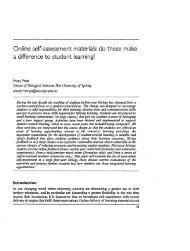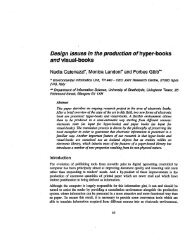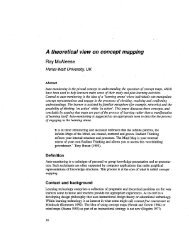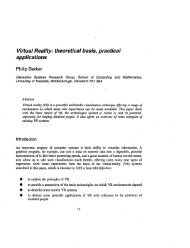Download (2177Kb) - ALT Open Access Repository - Association for ...
Download (2177Kb) - ALT Open Access Repository - Association for ...
Download (2177Kb) - ALT Open Access Repository - Association for ...
You also want an ePaper? Increase the reach of your titles
YUMPU automatically turns print PDFs into web optimized ePapers that Google loves.
0014 SP: Worlds of Learning<br />
Effective use of an asynchronous online voice system<br />
on Moodle in blended language learning<br />
Authors<br />
Terumi Miyazoe<br />
Terry Anderson<br />
Theme<br />
Making things happen<br />
Tags<br />
earlyResearch, learningDesign,<br />
voiceInteraction<br />
Interactive online voice interactions promise to enrich and add social<br />
presence to the text interactions that currently define online education<br />
systems. Reliable and easy-to-use online voice systems <strong>for</strong> teaching tools are<br />
scarce, and whether or how these online voice tools bring positive effects<br />
on the learning process is not known. This presentation reports on an<br />
empirical study that examined the effects of the systematic application of an<br />
asynchronous voice recording system integrated into the Moodle LMS. The<br />
study was conducted in a <strong>for</strong>eign language education context in which oral<br />
training is an essential component of the expected learning outcomes.<br />
The online voice activities were implemented over one semester at a<br />
university in Tokyo in two undergraduate English course classes comprising<br />
Engineering and Science major students (n = 127). The students were<br />
required to do two kinds of online voice recording, namely, reading a short<br />
text and reading a mini-speech aloud, as weekly out-of-class assignments.<br />
The asynchronous voice mode was designed to achieve the same results as<br />
were expected in synchronous oral communication in face-to-face classes.<br />
Pre- and post- course online questionnaires to evaluate this intervention<br />
were conducted. The survey included questions that rated the system<br />
usability using the System Usability Scale (Brooke, 1996) and asked about<br />
changes in attitudes towards speaking English. Quantitative and qualitative<br />
analyses of the data indicated that the students found the voice system to be<br />
usable enough to meet course objectives. The online voice assignments were<br />
associated with positive changes in the perceptions of the students with<br />
regard to speaking English. However, from a human-computer interaction<br />
perspective, half of the students were reluctant to use an online program,<br />
whereas the rest were willing to do so.<br />
The study concludes that asynchronous online voice activities can<br />
effectively support beginner-level <strong>for</strong>eign language learners in developing<br />
their oral abilities. The study also suggests the needs <strong>for</strong> improving specific<br />
areas of online voice systems such as sound quality and connectivity<br />
problems, as well as seamless integration into a learning management<br />
system such as the use of a stable linkage to the grading function and a<br />
friendly interface design.<br />
References<br />
Anderson, Terry, and Randy Garrison. 1998. Learning in a networked world: New roles and<br />
responsibilities. In Distance learners in higher education., ed. C. Gibson, 97-112. Madison, WI: Atwood<br />
Publishing.<br />
Brooke, J. 1996. SUS: A quick and dirty usability scale. In P. W. Jordan, B. Thomas, B. A.<br />
Weerdmeester & I. L. McClelland (Eds.), Usability evaluation in industry (no page number). London:<br />
Taylor & Francis.<br />
Millard, Mark O. 2010. Analysis of interaction in an asynchronous CMC environment. Paper presented at<br />
Proceedings of the WebSci10: Extending the Frontiers of Society On-Line, Raleigh, NC, USA.<br />
Miyazoe, Terumi, and Terry Anderson. 2010. Empirical research on learners’ perceptions: Interaction<br />
equivalency theorem in blended learning. European Journal of <strong>Open</strong>, Distance and E-Learning, www.<br />
eurodl.org/?article=397.<br />
15







